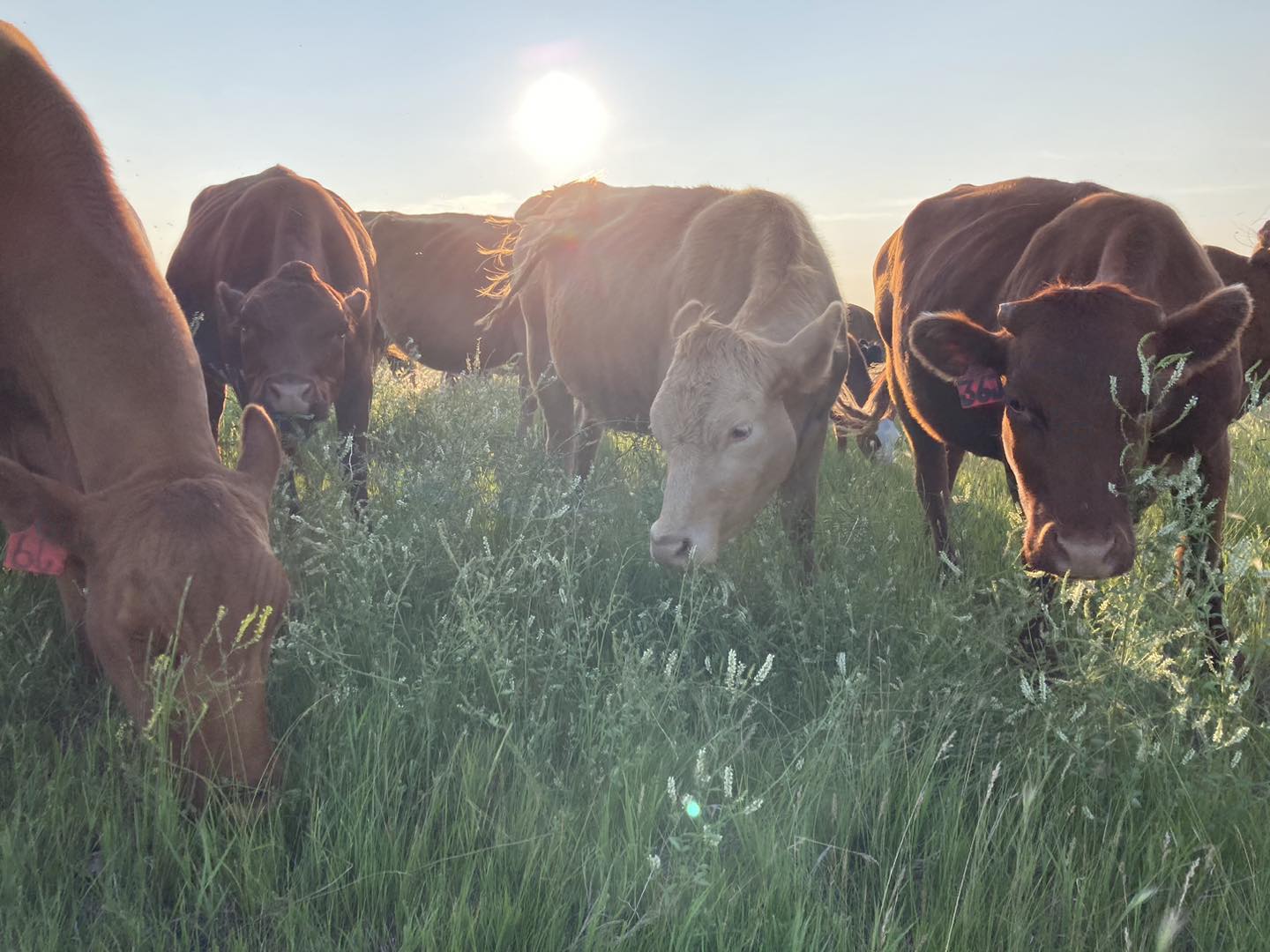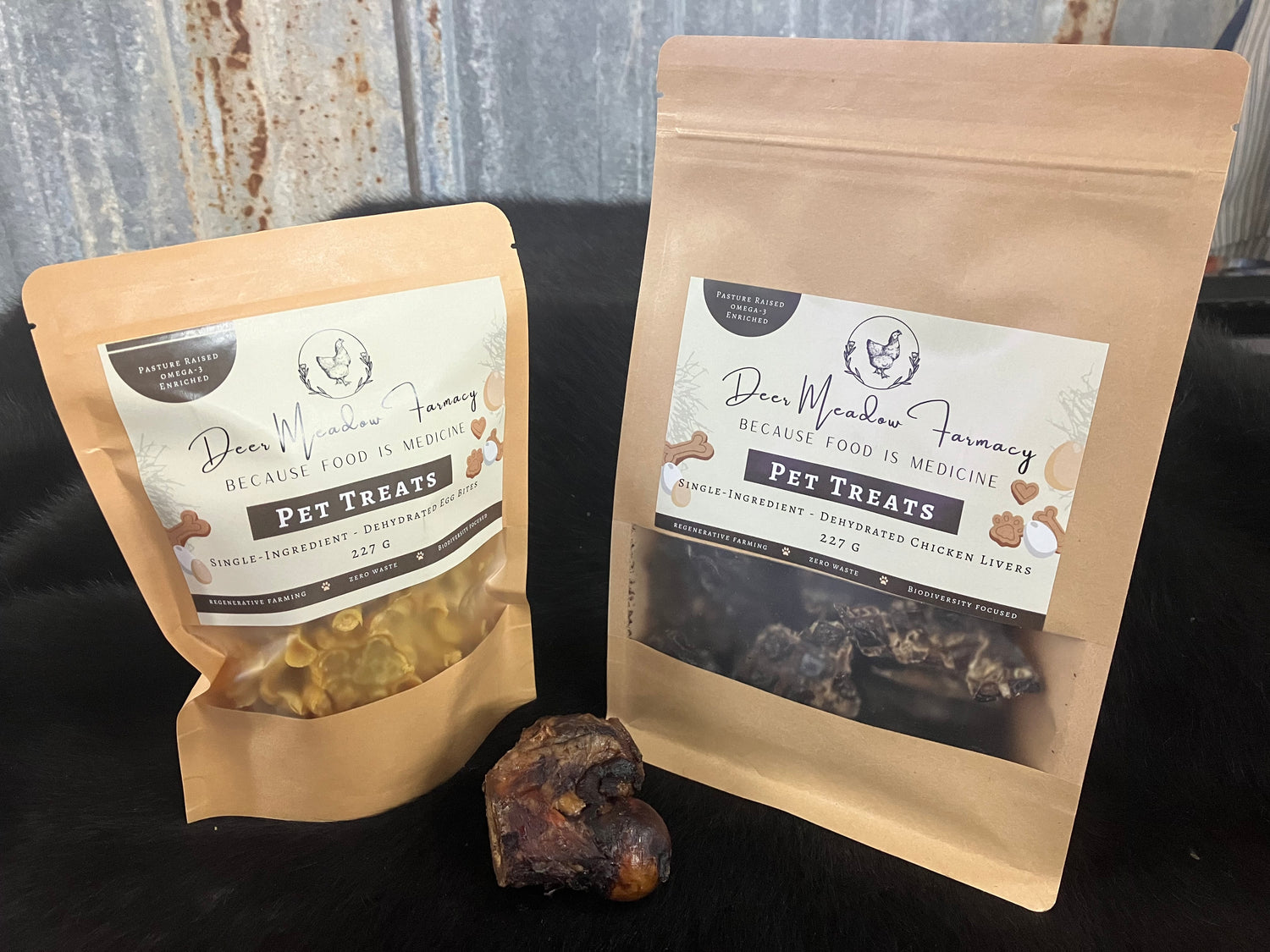About Our Products

Salad Bar Beef
Our beef is raised entirely on farm and on pasture for its entire life. We calve with the spring flush of growth in May and June and move the herd daily until early winter, when they’re moved closer to home to bale graze on hay. We allow the cows to wean the calves when they see fit in the winter, and finish the calves as steers on fresh pasture from spring through fall.
During their finishing period, they are moved to new grazing ground every day, sometimes multiple times per day, and are offered a veritable salad bar of fresh grasses, legumes and forbs, along with a limited amount of grain ration with milled flax for additional Omega-3 fats in the finished meat.
Over two thirds of our paddocks are partially forested, and we ensure that the animals are being grazed in those paddocks through the heat of the summer to allow them to stay cool in the shade. Under the canopy of a mature forest, the air temperature can be up to 10 degrees cooler, so heat stress is not an issue, even on the hottest days of summer.
Our steers are independently graded by our butcher when they are processed. They have graded from A to AAA, and we average a AA grade most years.
Typically, a quarter will hang at 170-200 pounds. We don’t sell by the front quarter or back quarter, so if you order a quarter, you’ll be getting a quarter of each cut available. For example, if there are 16 packages of ribeye steak off the whole animal, each quarter customer would get 4 packages. You don’t have to worry that if you buy a quarter, you’ll get stuck with a front shoulder and neck meat. You’re also able to have your quarter (or half, three quarters, etc.) cut to your own specifications. In keeping with the ribeye example, you could have yours cut into a rib roast instead of steaks.

Forest Raised Pork
We have a lot of mature forest on our home quarter, and because we heat our house and shop with an outdoor wood boiler, we can selectively harvest trees to allow more light to reach the ground for a more productive forest. Pigs pair perfectly with this more open canopy by rooting around and disturbing the seed bank to allow new seedlings to take advantage of the increased light filtering through! They will be moved to a new paddock at least once per week, and will be supplemented with grain, seasonal wild mushrooms, and nuts and fruits, such as acorns, chokecherries, Saskatoons and apples, along with plenty of LOOP produce.Pigs have the innate need to explore, forage and root around! Here at Deer Meadow Farmacy, we let all our pigs express their natural behavours. This allows them to thrive and really be as, “happy as a pig in muck”. Being able to soak up the sun and have a very diverse diet does not only benefit our pigs. This positively affects the environmental health and our consumers health.I can’t express enough how passionate we are about the health of our environment, our animals and our consumers. If you feel the same passion, please sign up to receive all our updates!

Pasture Raised Broilers
All of our chickens are raised on pasture for as long as the seasons will allow, and moved daily to every 3 days, depending on a variety of factors. Whenever possible, we follow our pasture finished steers with our chickens, roughly 4 days behind the cattle. This allow the dung beetles to do their work on re-locating the cow manure underground, and the chickens can then spread the remaining manure around on the ground before the pesky fly larvae can hatch.
Typically, our laying can go out into their wheeled “eggmobile” sometime in April. They lay in community nesting boxes equipped with rollaway nest mats to keep the eggs clean and safe. Because they are moved regularly, their diet is made up of a large percentage of grass, legumes and forbs, as well as a variety of insects and insect larvae. They are also supplied a balanced laying hen ration with milled flax added to increase the Omega-3 fat levels of the eggs. This management style and diet creates an extremely nutrient dense egg, and a very healthy, resilient laying hen.
Unfortunately, as resilient as our hens are, eventually their egg numbers decline. In keeping with our mindset of being an ethical, zero waste farm, we honour our old laying hens by turning them into a wonderful meal. They will typically dress between 2.5 and 3.5 pounds, and because they are much older than a broiler or roasting chicken, they are much better suited to soup, or better yet, chicken stew and dumplings! The bones and cartilage left over after the meal can then be used to make a silky, scrumptious broth. Their flavour will be very intense, and they will have more rich, brilliant yellow fat, pigmented by the beta carotene in the fresh forage that they have feasted on for over a year.
Our broiler chickens are raised in portable coops from May to October. They are started in our brooder facility to give them a good head start, then moved onto pasture at 3-4 weeks, depending on the weather. They are raised in their pasture coops for an additional 4-7 weeks, depending on the time of the year.
The chickens raised in the warmer part of the season will only be raised to 8 week broilers and 4-6 pounds dressed weight, to avoid unnecessary heat stress. This also times well with barbecue and smoker season, when smaller chickens means more chickens to allow a variety of seasonings, and faster cooking times.
When the temperatures are cool, we can raise our chickens to 10 week roasters and 6-8 pounds dressed weight, particularly if enough customers have requested larger chickens. This is more typical at the end of the season in October, when the chill of winter is in the air and our customers are dreaming of a succulent roast chicken dinner.
No matter the age or size of your chicken, we’re confident that it will be the best you’ve ever eaten, and we have plenty of customers who agree and would be happy to provide a reference!

Zero Waste Pet Treats
As the farm offerings have become more varied, so have our “waste products.” Personally, we don’t believe that anything should be considered a waste product, as almost everything has an alternative use. Bones, cartilage, tails, necks and feet are used to make broth and stock. Waste food from grocery stores and our own kitchen scraps can be used as animal feed or composted. Deadfall and diseased trees can be burned in our outdoor wood boiler to heat our house and shop. Small trees, limbs, woodchips and bedding straw can be used to grow mushrooms, then chipped or shredded and composted along with ashes and small piece of charcoal from our outdoor wood boiler. Inedible chicken processing by-products such as feathers, heads, blood and guts can be composted along with spent woodchips and straw, etc. and used to feed soil biology and plants. Excess chicken feet and necks that aren’t used for human consumption can be used to make pet treats, along with excess or dirty eggs. The eggshells can then be dried and ground to be used as a soil amendment for calcium-hungry plants such as tomatoes or roses. The list is endless and is only restricted by our imaginations, and our available time and energy.
Our pet treats are very simple. The necks and feet are available frozen or dehydrated, and are just that; necks and feet, nothing else added. The same goes for our dehydrated egg treats and ground eggshells. They are all single ingredient products with nothing to hide.
